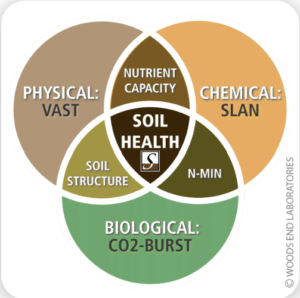Nitrogen (N) is an essential nutrient for plant growth, and its availability in the soil significantly impacts crop yields. However, nitrogen’s mobility in the soil and its forms—specifically nitrate and ammonium—pose challenges both for agricultural productivity and environmental sustainability. The following is an overview of nitrogen measurement in soil testing, the challenges associated with assessing nitrogen availability, and the implications for agricultural practices. We discuss the various nitrogen forms in the soil, the current state of nitrogen testing, and introduce an intermediate approach through SLAN (Solvita Labile Amino Nitrogen) as a practical solution.
The Importance of Nitrogen for Plant Growth
Nitrogen is a key macronutrient required for the growth of plants. It is found in soil in various forms, with the most important being nitrate (NO₃⁻) and ammonium (NH₄⁺). Both forms are directly usable by plants, and their availability is crucial for the proper development of crops. Nitrate, in particular, is a highly mobile nutrient, easily leached from the soil through irrigation or rainfall, which can result in significant environmental and health issues. Ammonium, on the other hand, is less mobile but is unstable in the soil, readily converting into nitrate.
Understanding the forms of nitrogen available to plants and how to accurately measure them is critical for efficient fertilizer management and environmental protection. However, current soil testing methods have their limitations, particularly in terms of directly measuring plant-available nitrogen.
Forms of Nitrogen in the Soil: Nitrate and Ammonium
Nitrate (NO₃⁻)
Nitrate is the most mobile form of nitrogen in soil and is readily taken up by plant roots for growth. However, its high mobility presents a challenge for agricultural management. Nitrate leaching occurs when excess nitrate in the soil is carried away by water, especially during irrigation or heavy rainfall. This leaching can lead to contamination of groundwater, which poses a serious risk to human health, particularly for infants, as high levels of nitrate in drinking water are linked to methemoglobinemia (blue baby syndrome).
Ammonium (NH₄⁺)
Ammonium is less mobile than nitrate and is typically absorbed by plants or converted into nitrate by soil microorganisms through nitrification. However, ammonium is not stable in the soil and is rapidly converted into nitrate, further contributing to the challenges of nitrogen management. Its transient nature in soil complicates nitrogen management and testing.
Nitrogen Measurement in Soil: Challenges and Current Methods
Soil testing labs commonly offer several methods for assessing nitrogen levels, but these methods have limitations:
Total Nitrogen Testing
Total Nitrogen (TN) testing, such as using a combustion analyzer, measures all forms of nitrogen present in the soil, including both organic and inorganic forms. However, this approach does not differentiate between nitrogen that is readily available to plants and that which is not. Total nitrogen testing requires specialized equipment and is costly, making it impractical for routine soil testing in many agricultural settings.
Plant-Available Nitrogen Testing
Most soil labs focus on measuring nitrogen in its plant-available forms—nitrate and ammonium. These tests are typically based on extracting a sample of soil and analyzing the concentrations of nitrate and ammonium. However, these tests only measure nitrogen that is immediately available to plants, which can be an oversimplified representation, as plants can also take up nitrogen that is slowly released from organic matter through microbial processes.
SLAN (Solvita Labile Amino Nitrogen) Testing
SLAN testing represents an intermediate approach, focusing on nitrogen that is potentially available to plants. SLAN measures nitrogen that is soluble in water and associated with amino acids in organic matter such as humus and plant debris. While SLAN does not directly detect ammonium or nitrate, it estimates the nitrogen that could become available to plants under the right conditions, depending on the microbial activity in the soil.
One of the major advantages of SLAN is that it accounts for nitrogen in organic forms that can be mineralized into nitrate or ammonium by soil microbes. It offers a more holistic approach to nitrogen availability, as it provides an estimate of nitrogen that could be released over time. However, it is important to note that SLAN results are dependent on the health of the soil microbial community, which plays a crucial role in the conversion of organic nitrogen into plant-available forms.
The Role of Soil Microbial Communities in Nitrogen Cycling
Soil microbial activity is essential to the nitrogen cycle, especially in the mineralization of organic nitrogen into forms that plants can use. The health and diversity of soil microorganisms—bacteria, fungi, and other microbes—determine how effectively nitrogen in organic matter is converted into ammonium and nitrate.
When a soil’s microbial community is healthy and balanced, it efficiently mineralizes the organic nitrogen present in humus, plant residues, and other organic matter. This process is particularly important in low-input agricultural systems, where soil microbial communities play a key role in nitrogen availability.
However, if microbial communities are stressed or imbalanced, the mineralization process is hindered, leading to insufficient nitrogen availability. This balance emphasizes the importance of maintaining healthy soil ecosystems for optimal nutrient cycling.
Practical Implications for Agricultural Management
Efficient Fertilizer Use
Understanding nitrogen availability is critical for effective fertilizer management. Over-fertilization with synthetic nitrogen fertilizers is not only wasteful but also increases the risk of environmental pollution. By utilizing SLAN, farmers can more accurately estimate the potential nitrogen available from organic sources, reducing the need for synthetic fertilizers and mitigating environmental risks.
Improved Environmental Stewardship
The ability to measure and manage nitrogen in the soil can help prevent water contamination from excess nitrate, improving the quality of local water sources. This is especially important for agricultural regions where irrigation or rainfall can quickly wash away excess nitrogen. By focusing on improving microbial health in the soil and using SLAN, farmers can reduce the risk of nitrate leaching and support sustainable agricultural practices.
Soil health is foundational to efficient nitrogen cycling. Practices such as crop rotation, cover cropping, and composting can enhance soil microbial activity, thereby improving nitrogen mineralization. The use of SLAN can help farmers better understand the nitrogen dynamics in their soils and implement practices that promote a healthy, thriving soil microbiome.
Looking to the future
Accurately measuring plant-available nitrogen in the soil is a critical component of sustainable agricultural practices. While traditional nitrogen tests have their limitations, SLAN testing offers a promising middle ground by estimating the nitrogen available from organic sources. Coupled with an understanding of soil microbial health, SLAN can help optimize nitrogen management, reduce environmental risks, and improve fertilizer efficiency.
The future of nitrogen management lies in bridging the gap between immediate plant-available forms of nitrogen and the slow-release organic nitrogen that depends on microbial activity.
Learn With Us

Optimizing Corn Yields with Nitrate and Tissue Testing
As corn enters its most critical growth stages, nitrogen management becomes a key driver of yield potential. Applying the right

What Your Soil Isn’t Telling You: The Power of Pairing Respiration with Organic Nitrogen
Spring is in full swing, and farmers and agronomists alike are gearing up for a new growing season. With the

5 Ways to Prepare for a Productive Growing Season
Spring is in full swing, and farmers and agronomists alike are gearing up for a new growing season. With the